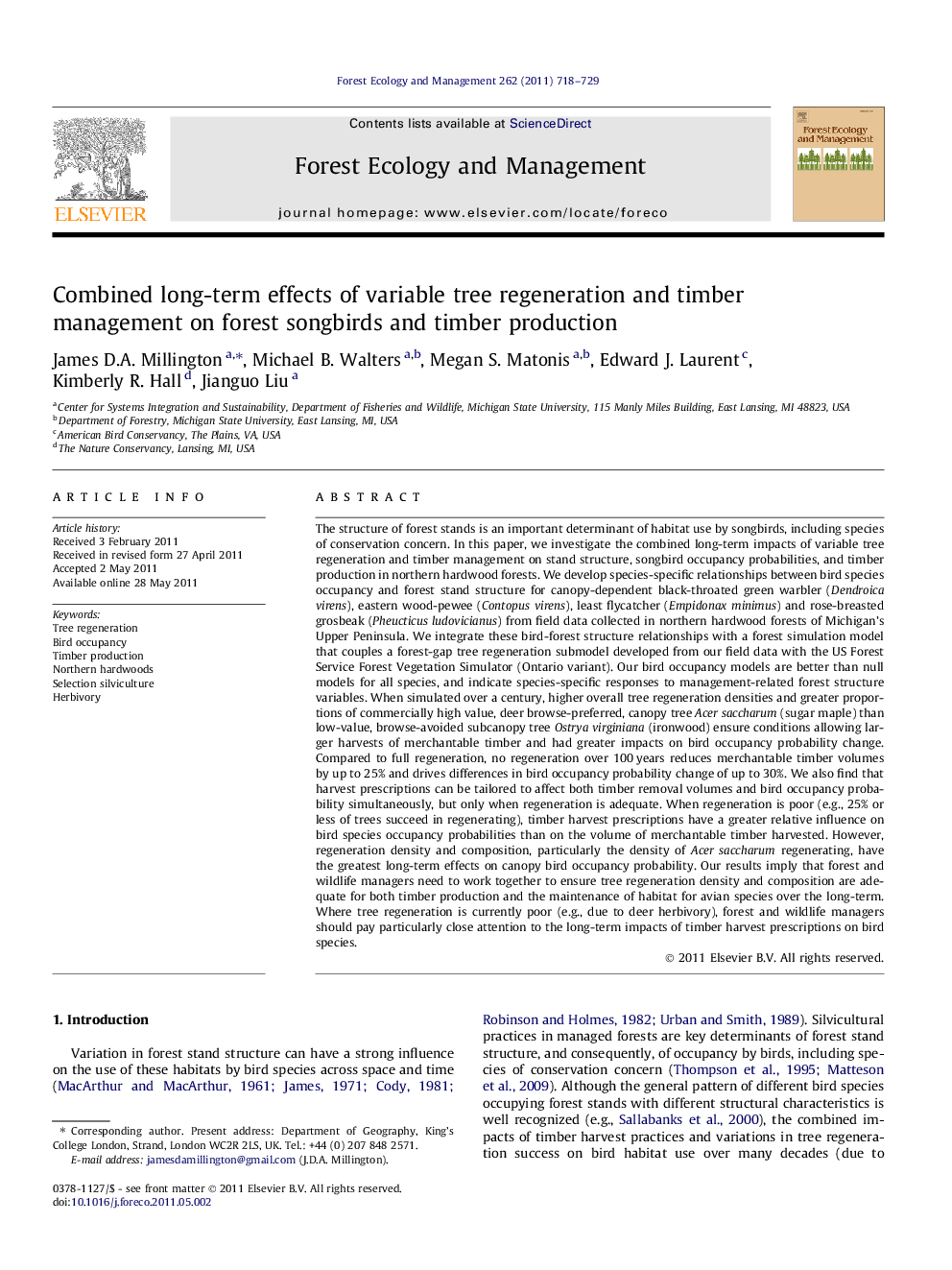| Article ID | Journal | Published Year | Pages | File Type |
|---|---|---|---|---|
| 88063 | Forest Ecology and Management | 2011 | 12 Pages |
The structure of forest stands is an important determinant of habitat use by songbirds, including species of conservation concern. In this paper, we investigate the combined long-term impacts of variable tree regeneration and timber management on stand structure, songbird occupancy probabilities, and timber production in northern hardwood forests. We develop species-specific relationships between bird species occupancy and forest stand structure for canopy-dependent black-throated green warbler (Dendroica virens), eastern wood-pewee (Contopus virens), least flycatcher (Empidonax minimus) and rose-breasted grosbeak (Pheucticus ludovicianus) from field data collected in northern hardwood forests of Michigan’s Upper Peninsula. We integrate these bird-forest structure relationships with a forest simulation model that couples a forest-gap tree regeneration submodel developed from our field data with the US Forest Service Forest Vegetation Simulator (Ontario variant). Our bird occupancy models are better than null models for all species, and indicate species-specific responses to management-related forest structure variables. When simulated over a century, higher overall tree regeneration densities and greater proportions of commercially high value, deer browse-preferred, canopy tree Acer saccharum (sugar maple) than low-value, browse-avoided subcanopy tree Ostrya virginiana (ironwood) ensure conditions allowing larger harvests of merchantable timber and had greater impacts on bird occupancy probability change. Compared to full regeneration, no regeneration over 100 years reduces merchantable timber volumes by up to 25% and drives differences in bird occupancy probability change of up to 30%. We also find that harvest prescriptions can be tailored to affect both timber removal volumes and bird occupancy probability simultaneously, but only when regeneration is adequate. When regeneration is poor (e.g., 25% or less of trees succeed in regenerating), timber harvest prescriptions have a greater relative influence on bird species occupancy probabilities than on the volume of merchantable timber harvested. However, regeneration density and composition, particularly the density of Acer saccharum regenerating, have the greatest long-term effects on canopy bird occupancy probability. Our results imply that forest and wildlife managers need to work together to ensure tree regeneration density and composition are adequate for both timber production and the maintenance of habitat for avian species over the long-term. Where tree regeneration is currently poor (e.g., due to deer herbivory), forest and wildlife managers should pay particularly close attention to the long-term impacts of timber harvest prescriptions on bird species.
Graphical abstractMean stand bird occupancy probability and merchantable timber removed by regeneration success rate (RSR) and harvest prescription for black-throated green. Occupancy probabilities are for year 100 of simulations. Simulations are for 100% sugar maple regeneration. Prescription specifications are presented in Table 1. Error bars are 95% confidence intervals from the standard error of three simulation replicates for each treatment.Figure optionsDownload full-size imageDownload as PowerPoint slideHighlights► We simulate centurial bird responses to variable tree regeneration and timber harvest. ► Better canopy-tree regeneration has greatest effect on bird occupancy probability. ► Timber harvests influence timber volume and birds more when regeneration is denser. ► Promoting good regeneration benefits both birds and timber production over long-term.
